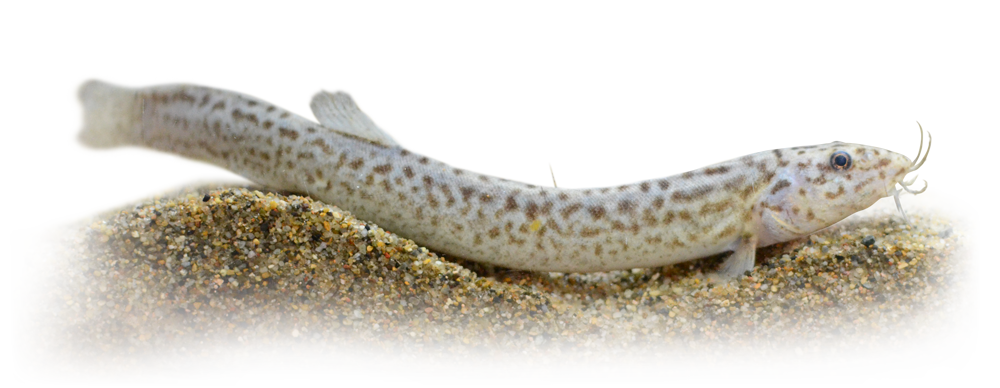
Misgurnus anguillicaudatus (Cantor, 1842)
日本のドジョウ文化
Loach in Japanese Culture
体長10 – 15cm、最大で20cmになります。体は細長く、全体に褐色を帯びており、背部から体側に不規則な斑紋があります。10本の口ひげをもち、上唇に3対6本、下唇に2対4本が生えています。日本全国の水田や湿地、農業用水路、泥底の流れの緩やかな小川などに生息しており、中国、台湾、朝鮮半島にも分布しています。
ドジョウは基本的には「エラ呼吸」と皮膚から直接酸素を取り込む「皮膚呼吸」をしています。また、十分な酸素がない時には「腸呼吸」も行います。腸呼吸とは口から空気を取り入れ、毛細血管が密集した腸管後部の後腸と呼ばれる粘膜の薄い部位で、酸素を取り込む仕組みです。このように呼吸法を変えられるのは様々な環境下で生き抜くために身につけた術であり、そのおかげで経済高度成長期の汚れた川で生き抜くことができたのです。しかし一方では、水田における農薬散布などに伴い大幅に数を減らしており、環境庁は本種を純絶滅危惧種に指定しています。
ドジョウは古くから食用として親しまれてきました。福岡県柳川市の「柳川鍋」もドジョウを使った郷土料理の一つです。実は柳川鍋の発祥は江戸であり、名前の由来は、その料理に使われた鍋が、柳川で焼かれた「柳川焼」という土鍋であったという説や、最初に提供した店の屋号が「柳川」であったという説など諸説あり、その料理が柳川に伝えられて名物料理となったわけです。ドジョウは臭みがありますが、柳川鍋は消臭効果があるゴボウを入れ、卵でとじることで独特の風味に仕上げています。
ドジョウは身近な生き物であるために、食用だけでなく多くの文化とも関わりがあり、各地で神事や祭事でドジョウを供えたり、池に放生したりして厄払いや供養が行われています。有名なのは島根県の郷土芸能「安来節」における「どじょうすくい踊り」です。これはドジョウをザルで掬い獲る様子をユーモラスなパントマイムで演じる演目です。若者が捕ってきたドジョウを肴に酒盛りを始めたところ、酔っ払ってドジョウを掬う仕草を安来節に合わせて即効的に踊ったのが始まりとされてます。ことわざでは「柳の下の泥鰌(どじょう)」が有名です。「一度うまくいったからといって、いつもうまくいくとは限らない」との意味で、さらに「二匹目のどじょう」とは「偶然の成功事例を当てにして利益を期待するさま」のことを言います。
They grow to a maximum length of 20cm, measuring 10-15cm in length. Their bodies are long and slender, brownish overall, with irregular markings on their backs and sides. They have ten barbels, with three pairs of six on their upper lip and two pairs of four on their lower lip. They inhabit rice paddies, wetlands, irrigation channels, and slow-flowing muddy streams throughout Japan, and are also found in China, Taiwan, and the Korean Peninsula.
Loaches primarily breathe through their gills and cutaneously, taking in oxygen directly through their skin. They also engage in intestinal breathing when oxygen is insufficient. Intestinal breathing involves taking in air through the mouth and absorbing oxygen through the thin, mucosal hindgut, a region densely packed with capillaries at the rear of the intestine. This ability to adapt breathing methods is a skill they developed to survive in a variety of environments, and it allowed them to survive in polluted rivers during the period of rapid economic growth. However, due to factors such as the use of pesticides in rice paddies, their numbers have drastically decreased, and the Environment Agency has designated this species as endangered.
Loaches have long been popular as food. “Yanagawa nabe,” a dish from Yanagawa City, Fukuoka Prefecture, is one local dish that uses loaches. Yanagawa nabe actually originated in the Edo period, and there are various theories about the origin of its name, including that the pot used for the dish was a “Yanagawa-yaki” earthenware pot baked in Yanagawa, or that the name of the restaurant that first served it was “Yanagawa.” The dish was then brought to Yanagawa and became a local specialty. Loaches have a strong odor, but Yanagawa nabe is made with burdock, which has deodorizing properties, and topped with egg, giving it a unique flavor.
Loaches are a familiar creature in Japan, and not only are they consumed as food, but they are also deeply connected to various cultures. They are offered at religious ceremonies and festivals throughout the country, and are released into ponds as offerings to ward off evil spirits and the dead. One famous example is the “Loach Scooping Dance” from the Shimane Prefecture folk performing art “Yasugi Bushi.” This is a humorous pantomime depicting the act of scooping loaches with a sieve. It is said to have originated when young people drank sake with the loaches they had caught and, in their drunken state, began improvising a dance to the tune of the Yasugi Bushi. Another famous proverb is “The Loach Under the Willow Tree.” This means that “just because something worked once doesn’t mean it will always work out,” and “the second loach” refers to “relying on a chance success story to expect profits.”
参考文献
東京都島しょ農林水産総合センター | 東京おさかな図鑑 | ドジョウ 2025年8月30日閲覧
日本テレビ | 所さんの目がテン! | 知識の宝庫!目がテン!ライブラリー | 驚き消臭力 ゴボウの謎 #617 | (2002年2月3日) 2025年8月30日閲覧
日本経済新聞 | 絶滅危惧の生物、41種増加 ドジョウも「準危惧種」に | (2018年5月23日) 2025年8月30日閲覧
たびらい | 柳川鍋|栄養満点!ご当地ドジョウ鍋/柳川 | (2014年2月1日) 2025年8月30日閲覧
ガジェット通信 | 「柳の下のどじょう」とはどんな意味の言葉?その類義語や対義語は? | (2022年6月25日) 2025年8月31日閲覧
九州大学総合研究博物館 | 平成28年度特別展示 にょろにょろ!ドジョウとウナギ 2025年8月31日閲覧